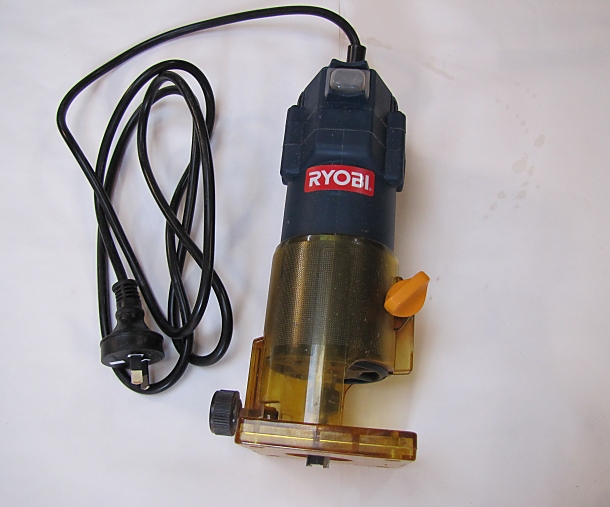The Blue View - Top 10 Power Tools to have Aboard
/If there is one recurring theme throughout my blog posts, it is that I have a lot of tools, spares and parts aboard. I've mentioned on more than a few occasions that Nine of Cups sits quite a bit a lower in the water because of all the added tonnage, and a lot of interior storage space is devoted to these items. Power tools are no exception, and I have quite a few. None are truly essential, I suppose. I do have handsaws, files, sanding blocks and a hand drill aboard, and, perhaps surprisingly, they are used frequently. But for most projects, power tools provide such a time and labor savings, that I think of them as almost essential.
The following is a list of my top ten power tools. It is somewhat in order, but the importance of a tool depends heavily on the project, so the order might well change frequently.
1. Electric Drill. This is, without doubt, the most used and probably most important power tool aboard. Try drilling a 3/8” hole through a stainless steel backing plate with a hand drill sometime if you are skeptical. When we first moved aboard Cups, I brought my heavy duty, 1/2” AC powered drill with me. I was not too fond of the NiCad powered tools that were available 15 years ago, but I now have a second, Lithium Ion powered drill aboard that is quite satisfactory for most day-to-day projects. While there are some projects that still require the big guy, my Ryobi 18V drill handles most of the everyday projects.
 2. Angle Grinder. Before we moved aboard Cups, I didn't even know what this tool was or why I would need one. It is a hand held tool with a 3-1/2” to 5” high speed rotating wheel. You can get a variety of wheels for it – grinding, cutting, sanding, polishing. It is sort of a Dremel tool on steroids. When I was replacing our fuel tanks, I used a metal cutting wheel to cut out the old tanks. When I was doing the deck repair job, it quickly cut out the deck sections with a cutting wheel, then smoothed the inner surfaces with a sanding wheel. I have polished stainless parts with a succession of fine sanding wheels followed by a polishing wheel. I have used it innumerable times when doing fiberglass repairs or for shaping hunks of metal when fabricating a part. It has a myriad of uses aboard. It also has some drawbacks. It is a very aggressive tool and can very quickly remove, cut or grind a lot more material than you intended. It has a powerful motor with a lot of torque. Unlike a Dremel tool, the motor won't stall if it binds as it is cutting through a material, but will kick back instead. Since it can be locked in the 'On' position, it can be quite dangerous if it gets out of your hands. In addition, it is very loud and generates an amazing amount of dust, sparks, dirt and/or debris. Given all its drawbacks, it is still a very important tool to have aboard.
2. Angle Grinder. Before we moved aboard Cups, I didn't even know what this tool was or why I would need one. It is a hand held tool with a 3-1/2” to 5” high speed rotating wheel. You can get a variety of wheels for it – grinding, cutting, sanding, polishing. It is sort of a Dremel tool on steroids. When I was replacing our fuel tanks, I used a metal cutting wheel to cut out the old tanks. When I was doing the deck repair job, it quickly cut out the deck sections with a cutting wheel, then smoothed the inner surfaces with a sanding wheel. I have polished stainless parts with a succession of fine sanding wheels followed by a polishing wheel. I have used it innumerable times when doing fiberglass repairs or for shaping hunks of metal when fabricating a part. It has a myriad of uses aboard. It also has some drawbacks. It is a very aggressive tool and can very quickly remove, cut or grind a lot more material than you intended. It has a powerful motor with a lot of torque. Unlike a Dremel tool, the motor won't stall if it binds as it is cutting through a material, but will kick back instead. Since it can be locked in the 'On' position, it can be quite dangerous if it gets out of your hands. In addition, it is very loud and generates an amazing amount of dust, sparks, dirt and/or debris. Given all its drawbacks, it is still a very important tool to have aboard.
3. Jig Saw. I have a small, inexpensive Makita jig saw with a variety of blades for cutting wood, plastic and metal. It has been with us since our first year aboard and gets a lot of use.
4. Dremel tool. My trusty Dremel is important enough to have rated its own blog post. I won't repeat it all here, but hardly a week goes by that I don't dig it out for some task.
5. Sander. I have a Makita palm sander that sees a lot of action. If it ever dies, I might consider replacing it with a random orbital sander, but until then, I am quite happy with the one I have.
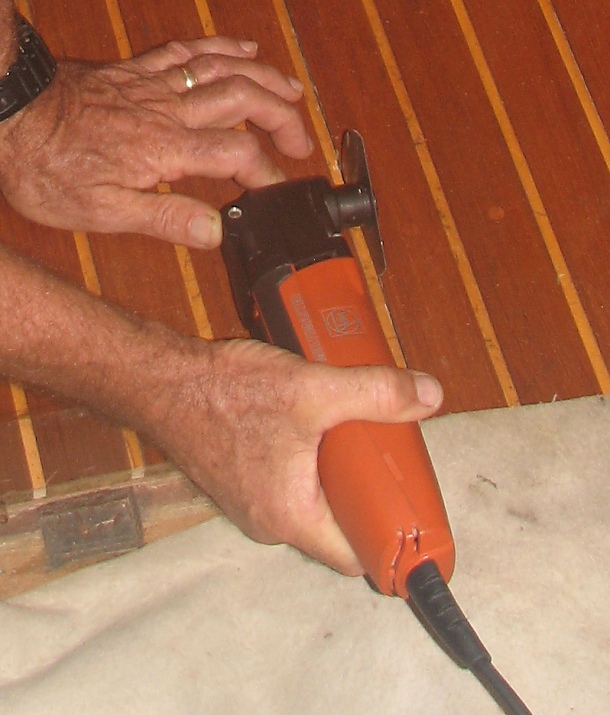 6. Multi-tool. Until a couple of years ago, the Fein company had a patent on this technology, and the cost of one of their tool was hundreds of dollars. Now that their patent has expired, most all the major tool companies have their own version of the multi-tool, and the price has dropped dramatically. It has three attachments, all of which utilize a very high speed oscillatory action. Instead of a rotating wheel, the attachment vibrates at a very high speed. It has a cutting blade for cutting metal, wood or plastic. The blade is very thin, and since it vibrates instead of rotating, it makes very fine, controlled cuts. It also has a sanding attachment that does a great job in small, hard to get to areas. The third attachment is for stripping finishes. I haven't tried this attachment yet, but if it works as well as the others, it will be used frequently aboard Cups.
6. Multi-tool. Until a couple of years ago, the Fein company had a patent on this technology, and the cost of one of their tool was hundreds of dollars. Now that their patent has expired, most all the major tool companies have their own version of the multi-tool, and the price has dropped dramatically. It has three attachments, all of which utilize a very high speed oscillatory action. Instead of a rotating wheel, the attachment vibrates at a very high speed. It has a cutting blade for cutting metal, wood or plastic. The blade is very thin, and since it vibrates instead of rotating, it makes very fine, controlled cuts. It also has a sanding attachment that does a great job in small, hard to get to areas. The third attachment is for stripping finishes. I haven't tried this attachment yet, but if it works as well as the others, it will be used frequently aboard Cups.
7. Vacuum. We originally had a small, hand held battery powered vacuum. If you wanted to pick up a few dropped crumbs and the battery hadn't gone flat, it was almost adequate. For any serious vacuuming task, it was hopeless. We then invested in a Panasonic portable household vacuum. It has a permanent filtering system in it that does not use bags – a big plus for us. It has a hose, so I can use it when I'm sawing or sanding something to keep the dust in check before it gets everywhere. And it is powerful enough to get the dirt out of those little cracks and crannies. It does a good job on our louvered-door lockers, too
8. Gasoline Generator. We have a small, quiet, efficient 2kva gas generator that sees a lot of use when we are away from the marina, which is usually about 10 months out of every year. The solar and wind generators can keep up with our needs for the most part, but if I am doing a project that requires one of the other power tools on this list for any length of time, I fire up the generator. If it is cloudy and/or calm, the generator can power the battery charger to recharge the house batteries. Or if I am doing some lengthy underwater maintenance, I power my hookah system with it. It is stored below decks when not in use, but I always make sure to run the engine and internal fuel tank dry before bringing it below.
9. Heat Gun. Another tool I didn't know I needed. It is great when used with a paint scraper when it is time to strip the old varnish off and refinish the brightwork. If you soften the old varnish with the heat gun, the scraper quickly removes it in long strips. I also use it for shrinking heat shrink tubing, and it is much better than using a match or torch for this job.
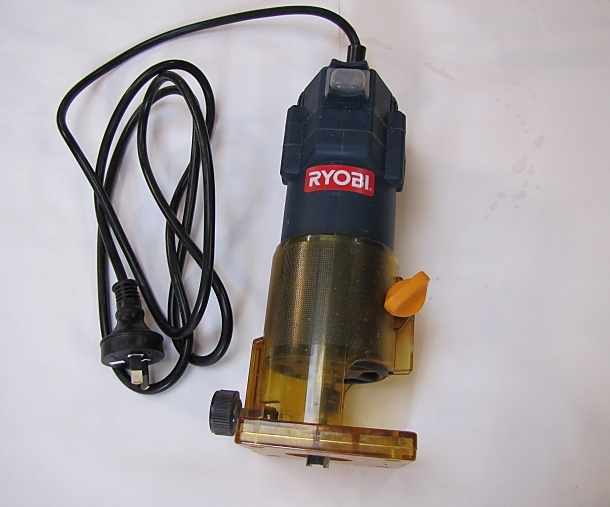 10. Router. Last on the list is my router and laminate trimmer. I have a router attachment for my Dremel tool which is reasonable for small jobs. When I embarked on the refrigerator/freezer project, there was a lot of routing to be done which was much more than the Dremel could handle. The local Australian 'Big Box' home supply store had a discontinued Ryobi router on the discount bargain table, so I picked it up. It has been invaluable on this project, but I'm not sure, yet, how much I will use it in the future. I think its two biggest drawbacks aboard are how much sawdust it generates and how loud it is. It may end up being traded for something more useful at a future swap meet somewhere.
10. Router. Last on the list is my router and laminate trimmer. I have a router attachment for my Dremel tool which is reasonable for small jobs. When I embarked on the refrigerator/freezer project, there was a lot of routing to be done which was much more than the Dremel could handle. The local Australian 'Big Box' home supply store had a discontinued Ryobi router on the discount bargain table, so I picked it up. It has been invaluable on this project, but I'm not sure, yet, how much I will use it in the future. I think its two biggest drawbacks aboard are how much sawdust it generates and how loud it is. It may end up being traded for something more useful at a future swap meet somewhere.
Honorable Mentions
There are a few more tools that didn't quite make the Top 10 list, but are worthy of a mention:
1. Air Compressor. This is the heart of my hookah system. I also use it for pressure checking plumbing and the refrigeration system, blowing out clogged orifices and jets, and several other tasks.
2. Circular Saw. I no longer have a circular saw aboard. The one I had died a few years ago and I didn't replace it. While it did see a fair amount of use, there aren't that many jobs that can't be done reasonably well with either a hand saw or the jig saw. If I were to replace it, I'd go with the Ryobi battery-powered version.
3. Vacuum Pump. We have a small vacuum pump aboard that is used when we or another cruiser have a problem with a refrigerator/freezer. (Seems like a frequent theme in my blogs, doesn't it?). If you have a component failure or a leak, the system must be pumped down to a vacuum before recharging with refrigerant. Ideally, you would refill it with nitrogen gas and pump it down a second time to help purge the system of any residual air or moisture in the system, but this isn't practical for most of us. The vacuum pump can also be used when vacuum bagging an epoxy or fiberglass repair when it is desirable to apply an even pressure over a large area.
So that's my list aboard Nine of Cups. What tools do you consider essential aboard your boat?


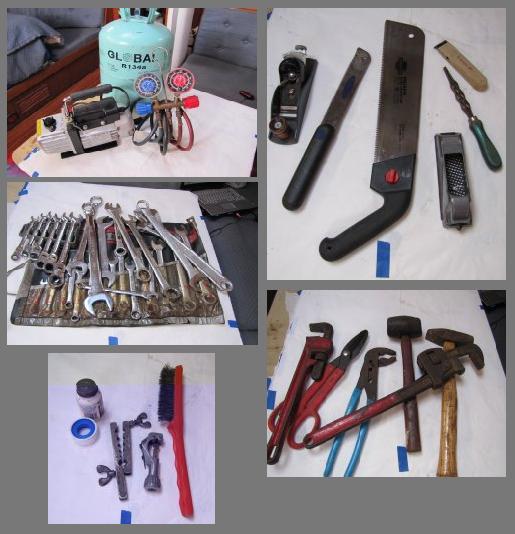

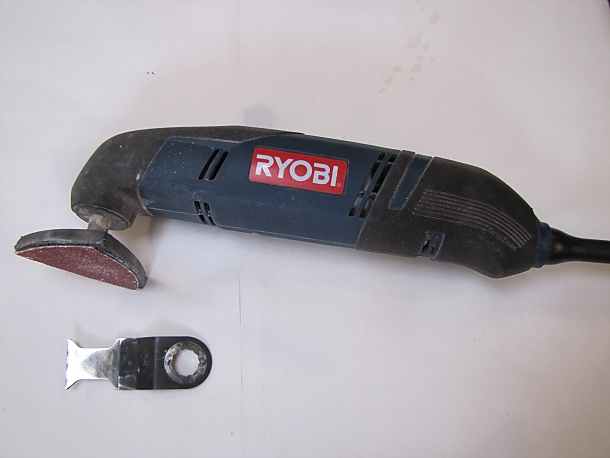
 . The cutting attachment was invaluable for removing the teak trim with minimal damage, and I used it for most of the demolition work. The sanding attachment also saw many hours of use in faring and shaping the new hatches and frames.
. The cutting attachment was invaluable for removing the teak trim with minimal damage, and I used it for most of the demolition work. The sanding attachment also saw many hours of use in faring and shaping the new hatches and frames.